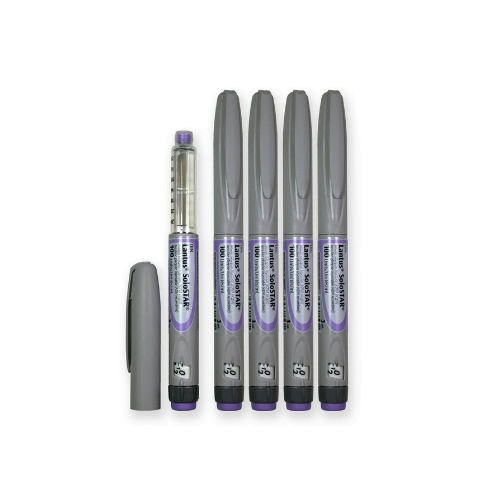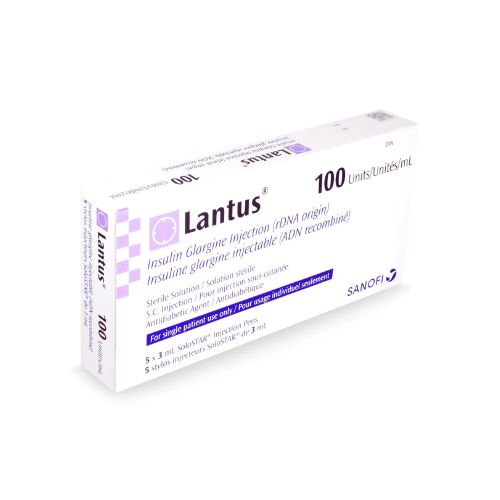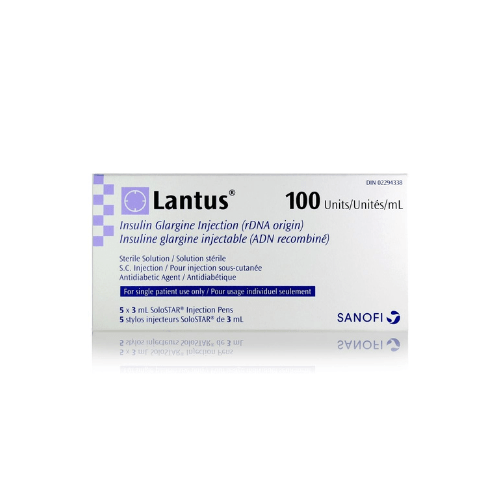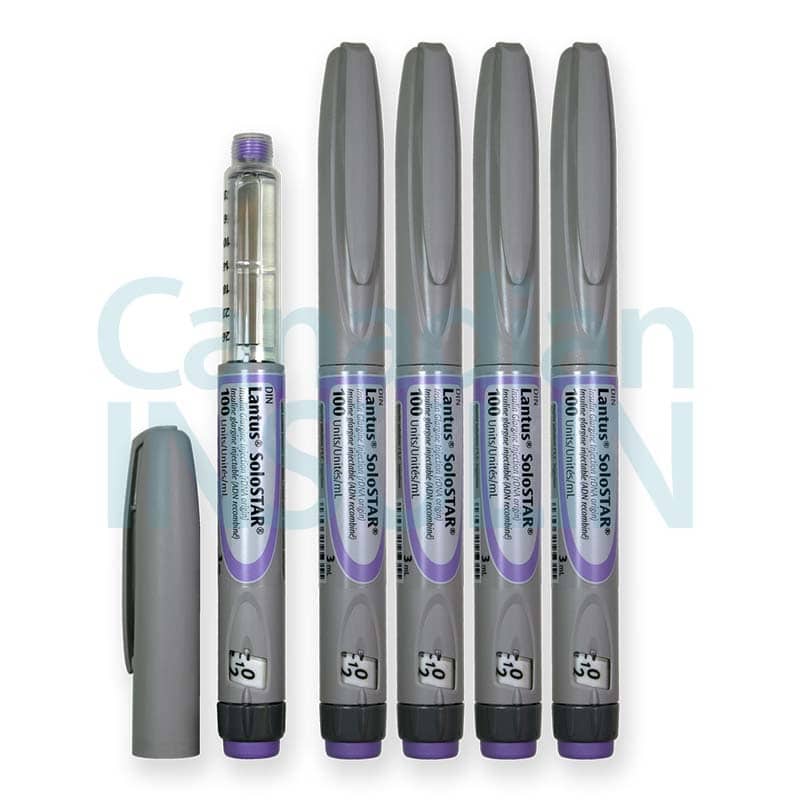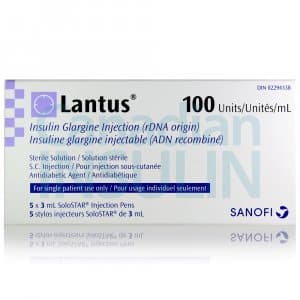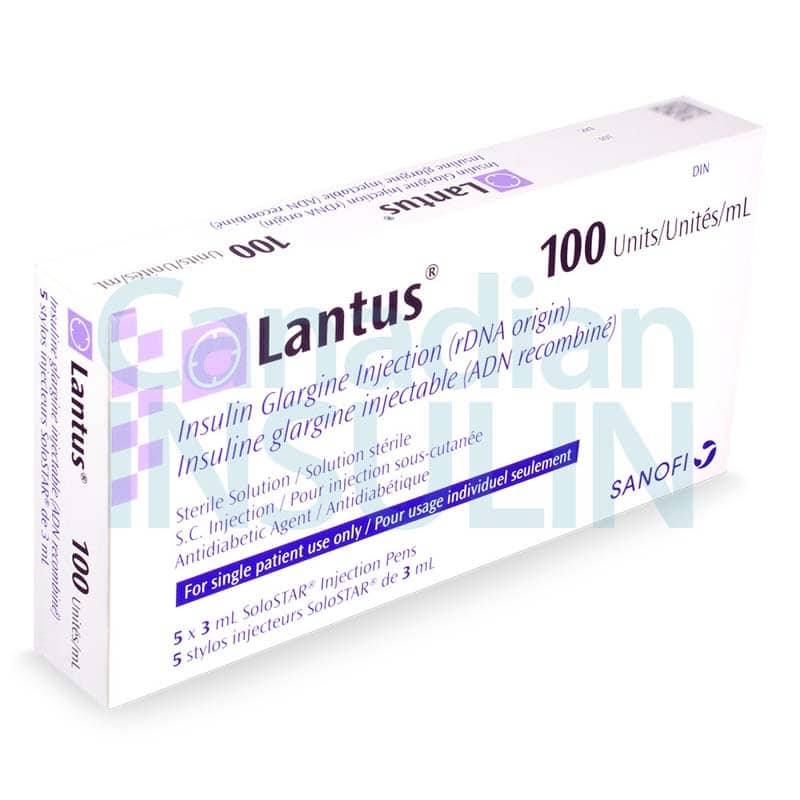Please note: a valid prescription is required for all prescription medication.
Lantus® SoloStar Pens for Diabetes
Also available for your pet.
Save an extra 15% by using promo code 15SAVE. Buying for your furry family, use PET15 to enjoy the same discount.
Maximize your savings with Canadian Insulin: Buy 2 for a 10% discount, or stock up with 3 or more to unlock an incredible 20% off on your insulin needs!
$177.77
You save


Lantus® SoloStar is a long-acting insulin pen that provides steady, once daily basal insulin for glucose control. It supports adults with type 2 diabetes and adults and children with type 1 in managing fasting and between-meal blood sugar. With US delivery from Canada at Canadian pricing, many choose Lantus Solostar Pens to lower cash costs, including those paying without insurance.
What Lantus® Is and How It Works
Lantus contains insulin glargine, a long-acting insulin analog. After subcutaneous injection, microprecipitates form in the tissue and release small amounts of insulin glargine over many hours. This gradual release helps limit peaks and provides a consistent basal effect through the day and night. The goal is to control glucose between meals and during sleep while complementing mealtime insulin when needed.
At CanadianInsulin, orders are filled by licensed Canadian pharmacies after we confirm a valid prescription with your clinic. Lantus SoloStar is a prefilled disposable pen designed for clear, simple dosing. It belongs to the family of Insulin Pens that many patients find convenient to carry and use. Lantus is not for treating diabetic ketoacidosis. It should not be used in an insulin pump and should not be administered intravenously or mixed with other insulins.
Who Lantus® Is For
Lantus is indicated to improve glycemic control in adults with type 2 diabetes and in adults and pediatric patients with type 1 diabetes. For pediatric use, it is typically used for children 6 years and older with type 1 diabetes. It is not indicated for pediatric patients with type 2 diabetes. Those with recurrent severe hypoglycemia or hypersensitivity to insulin glargine or any excipients should avoid use. Caution is appropriate in people with kidney or liver impairment and in any condition that raises hypoglycemia risk. During pregnancy or breastfeeding, clinicians weigh the benefits and monitor closely.
For condition overviews and treatment basics, see Type 2 Diabetes.
Dosage and Usage
Lantus is generally injected once daily at the same time each day. Dosing is individualized. In adults with type 2 diabetes, many clinicians start basal insulin at a fixed low unit amount or a weight-based dose, then adjust based on fasting glucose and overall response. In type 1 diabetes, Lantus serves as the basal component of a basal-bolus regimen, with rapid-acting insulin used at meals. Titration aims to achieve fasting glucose targets without increasing hypoglycemia.
Usage basics include checking the pen label, attaching a new sterile needle for each injection, priming the pen per instructions, dialing the prescribed dose, and injecting into recommended sites such as the abdomen, thigh, or upper arm. Rotate sites to reduce lipodystrophy. Do not share pens or needles. Do not mix Lantus with other insulins and do not dilute it.
Strengths and Forms
Lantus is available as insulin glargine U-100 (100 units/mL). Common presentations include the SoloStar prefilled disposable pen containing 3 mL, often supplied in cartons, a 10 mL vial for syringe use, and 3 mL cartridges for compatible reusable pens. Availability can vary.
If a vial format is preferred, review Lantus Vial. For pen-cartridge systems, see Lantus Cartridges.
Missed Dose and Timing
If a dose is missed, take it when remembered on the same day, then return to the usual schedule. If it is nearly time for the next dose, skip the missed dose and resume the regular time. Do not take extra insulin to make up for a missed dose. Keep consistent daily timing to maintain a stable basal level. Discuss individualized plans for shift work or travel across time zones with a clinician.
Storage and Travel Basics
Unopened Lantus SoloStar pens are typically stored refrigerated. Do not freeze. Protect from heat and direct light. Once in use, most pens may be stored at controlled room temperature and kept out of excessive heat; discard open pens after the labeled in-use period. Avoid leaving insulin in a hot car or near freezing temperatures. During trips, carry insulin in hand luggage with a contingency plan for temperature control. A simple pen case or insulated pouch helps keep supplies organized.
For detailed handling notes, read Lantus Storage. Temperature-sensitive items ship with cold-chain handling and insulated packaging.
Pen Handling and Sharps Disposal
For SoloStar use, follow the device Instructions for Use that accompany the pen. General steps include:
- Wash hands, check the label, and inspect the solution.
- Attach a new needle. Prime the pen as directed until a drop appears.
- Dial the prescribed dose. Pinch, insert, and inject at the recommended site.
- Hold the pen in place for the recommended time to ensure delivery.
- Remove and discard the needle in a sharps container. Never reuse a needle.
- Do not share pens or needles.
For a step-by-step refresher, see Use Insulin Pen.
Benefits
- Once-daily basal insulin designed for a smooth, sustained effect without a pronounced peak.
- Helps improve fasting and between-meal glucose and supports A1C reduction when appropriately titrated.
- Flexible dosing time of day when kept consistent, aiding routine adherence.
- Well-established option with decades of clinical use and broad experience in both type 1 and type 2 diabetes.
- Prefilled disposable pen offers portability and straightforward dose dialing.
Side Effects and Safety
- Hypoglycemia is the most common adverse effect; symptoms may include shakiness, sweating, dizziness, and confusion.
- Injection-site reactions such as redness, itching, or mild pain.
- Weight changes and peripheral edema in some patients.
- Lipodystrophy or localized skin changes with repeated injections at the same site.
- Allergic reactions ranging from rash to, rarely, more serious hypersensitivity.
Serious risks include severe hypoglycemia, hypokalemia, and fluid retention, especially if used with thiazolidinediones in those with heart disease. Always keep a source of fast-acting carbohydrate available for suspected lows. Contact emergency services for severe reactions or loss of consciousness.
Drug Interactions and Cautions
- Medications that lower blood glucose (other insulins, GLP-1 agonists) may increase hypoglycemia risk; additive effects require monitoring.
- SGLT2 inhibitors can be associated with ketoacidosis; discuss sick-day rules and warning signs.
- Thiazolidinediones may cause fluid retention; monitor for heart failure symptoms when used together.
- Beta blockers can mask adrenergic symptoms of hypoglycemia; monitor glucose diligently.
- Alcohol may potentiate hypoglycemia; use caution.
- Glucocorticoids, some antipsychotics, and certain antivirals can raise glucose requirements.
Kidney or liver impairment, changes in physical activity, weight, diet, or concurrent illness can alter insulin needs. Dose decisions belong to a clinician who can assess the full picture.
What to Expect Over Time
With consistent use and titration by a clinician, basal insulin can gradually improve fasting glucose and contribute to lower A1C. Many patients notice fewer overnight highs and more predictable morning readings. It can take time and data to fine-tune the dose, and adjustments may occur with seasonal changes, activity levels, or other medicines. Ongoing education on hypoglycemia recognition and injection technique remains important.
Compare With Alternatives
Other long-acting options may fit particular needs. Insulin glargine biosimilar products can offer similar clinical performance and may help manage costs. Consider Basaglar Online as a glargine alternative. Insulin degludec provides an ultra-long profile with flexible timing; see Tresiba Flextouch Pens for details. Clinicians may also consider a higher-strength glargine formulation for patients who need larger basal doses.
Pricing and Access
Many patients find Canadian pricing offers meaningful savings compared with typical US cash costs. If paying out of pocket, transparent options and refill support can simplify planning. To stretch budgets, consider multi-pen orders when appropriate and align refills to reduce separate shipments. See our Bulk Savings category for bundled value. Looking for current deals or tips? Visit our promotions page. Orders are dispensed by licensed Canadian pharmacies with straightforward US access through our service.
Availability and Substitutions
If a particular presentation is temporarily unavailable, a prescriber may recommend a clinically appropriate alternative insulin or presentation. Options include vial-and-syringe use or comparable basal insulins. Pharmacists will not substitute prescription medicines without prescriber authorization.
Patient Suitability and Cost-Saving Tips
- Good candidates include adults with type 2 diabetes needing basal support and patients with type 1 who require long-acting insulin alongside mealtime insulin.
- Those with frequent severe lows or insulin allergies need careful evaluation and monitoring.
- Ordering a multi-month supply when approved can reduce per-shipment costs and help maintain continuity.
- Set refill reminders so pens arrive before the in-use pen expires.
- Keep a travel kit with spare needles, alcohol swabs, and a backup pen. Store in carry-on luggage.
- Review injection technique periodically to improve consistency and reduce site irritation.
Questions to Ask Your Clinician
- What starting basal dose and target fasting range fit my situation?
- How should I adjust the dose based on home glucose readings?
- What signs of hypoglycemia should I watch most closely, and what is my treatment plan?
- How do other medicines I take affect insulin needs?
- What is the best injection site rotation plan for me?
- How should I adjust for travel across time zones?
Authoritative Sources
Ready to request Lantus Solostar Pens with prompt, express, cold-chain shipping? Place your prescription order through CanadianInsulin for trusted US delivery from Canada.
Disclaimer: This information is educational and does not replace medical advice. Use prescription medicines only as directed by a qualified clinician.
Express Shipping - from $25.00
Shipping with this method takes 3-5 days
Prices:
- Dry-Packed Products $25.00
- Cold-Packed Products $35.00
Standard Shipping - $15.00
Shipping with this method takes 5-10 days
Prices:
- Dry-Packed Products $15.00
- Not available for Cold-Packed products
What is Lantus SoloStar and how does it work?
Lantus SoloStar is a prefilled pen containing insulin glargine, a long-acting basal insulin. After subcutaneous injection, it releases insulin slowly over many hours to help control blood sugar between meals and overnight. It is taken once daily at the same time each day and is not mixed with other insulins.
Who can use Lantus SoloStar pens?
Lantus is indicated for adults with type 2 diabetes and for adults and pediatric patients with type 1 diabetes. It is not indicated for pediatric type 2 diabetes. People with recurrent severe hypoglycemia or allergy to insulin glargine should avoid use and discuss alternatives with their clinician.
How long does an opened Lantus pen last?
In-use Lantus SoloStar pens are typically kept at room temperature and protected from heat and light. Most should be discarded after the labeled in-use period (often 28 days). Do not refrigerate a pen currently in use if the label instructs room temperature storage. Always follow the product’s Instructions for Use.
Can Lantus be mixed with other insulin?
No. Lantus (insulin glargine) should not be mixed with other insulins and should not be diluted. Mixing can change its action profile and increase the risk of dosing errors or hypoglycemia.
What if I miss a dose of Lantus?
Take the missed dose when remembered on the same day, then resume your usual schedule. If it is close to the next dose time, skip the missed dose and do not double up. Monitor glucose closely and seek clinician guidance for individualized plans.
What are common side effects of Lantus?
The most common side effect is hypoglycemia. Others include injection-site reactions, weight changes, edema, and skin changes at repeated injection sites. Severe allergic reactions are rare but require urgent care.
Can I buy Lantus Solostar Pens without insurance?
Yes. Lantus Solostar Pens are available with a valid prescription. Many customers choose our US delivery from Canada to access Canadian pricing and pay out of pocket when they do not use insurance.
Rewards Program
Earn points on birthdays, product orders, reviews, friend referrals, and more! Enjoy your medication at unparalleled discounts while reaping rewards for every step you take with us.
You can read more about rewards here.
POINT VALUE
How to earn points
- 1Create an account and start earning.
- 2Earn points every time you shop or perform certain actions.
- 3Redeem points for exclusive discounts.
You Might Also Like
Related Articles
Join the Cause: American Diabetes Month 2025
Every November, millions of Americans come together to shine a light on one of the country’s most pressing health challenges — diabetes. American Diabetes Month is more than just a…
Orforglipron vs Rybelsus: Which Is More Effective?
According to the International Diabetes Federation (IDF), around 589 million adults aged 20–79 are living with diabetes globally. This marks the need for immediate medical action and treatment. Fortunately, with…
How to Travel with Ozempic: Keep Your Dose Effective
Vacations, business trips, and weekend getaways shouldn’t interfere with your health routine. For people using Ozempic, planning ahead is key to keeping your medication safe and effective while on the…
What Is Onsior Cat Medicine Used For?
If your cat has ever had surgery, dental work, or an injury, you know how vital pain relief can be for recovery and comfort. Onsior cat medicine is a veterinary-approved…


